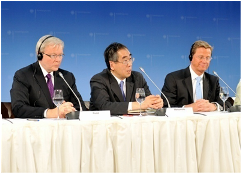|
1. “Open
Reconstruction” in the Aftermath of the Great East Japan Earthquake
2.
The MDGs Follow-up Meeting
3.
The 20th Japan-EU Summit
4.
G8 Deauville Summit
5.
2011 OECD Ministerial Council Meeting
6.
The Fourth Japan-China-ROK Trilateral Summit Meeting
7.
The Third TICAD Ministerial Follow-Up Meeting
8.
The Second Foreign Ministers’ Meeting on Nuclear Disarmament and
Non-Proliferation
|
|
|
JICC
Newsletter
No.4, June 2011 |
8. The
Second Foreign Ministers’ Meeting on Nuclear Disarmament and
Non-Proliferation
Setting
Out Concrete Proposals for the Reduction of Nuclear Risks


On April 30, ten non-nuclear-weapon states from diverse regions
across the globe – Australia, Canada, Chile, Germany, Japan, Mexico,
the Netherlands, Poland, Turkey, and the United Arab Emirates – held
the 2nd Foreign Ministers’ Meeting on Nuclear Disarmament and
Non-Proliferation in Berlin, chaired by Foreign Minister of Germany
Guido Westerwelle. From Japan, Foreign Minister Takeaki Matsumoto
attended the meeting.
Japan’s Proposal
At the meeting, Japan’s Foreign Minster Matsumoto started off his
address by expressing his gratitude to all the participating
countries for their offer of assistance to Japan in the wake of the
Great East Japan Earthquake. As for the nuclear accident at TEPCO’s
Fukushima Dai-ichi Nuclear Power Station, Foreign Minster Matsumoto
explained that Japan is entering the phase that is aimed at settling
the situation in a planned manner. He expressed Japan’s intention to
thoroughly investigate the accident and share the knowledge and
experience gained from it with the international community with
maximum transparency. Foreign Minster Matsumoto then welcomed the
fact that the efforts by these ten countries are entering the phase
of concrete action with the keyword “reducing nuclear risks.” Noting
the importance of starting negotiations towards a Fissile Material
Cut-off Treaty (FMCT), ensuring transparency in nuclear disarmament,
and striving for nuclear non-proliferation, Foreign Minister
Matsumoto proposed that the foreign ministers of the ten countries
gather their political will to take action based on concrete
proposals.
Berlin Statement
Towards the end of the meeting, the participants referred to the
importance of reducing nuclear risks, their determination to
steadily implement the agreement of the NPT Review Conference 2010,
and the necessity to strengthen nuclear security. They unanimously
adopted the Berlin Statement – the outcome document that contains
concrete proposals that call for, among other goals, the immediate
commencement of FMCT negotiations, early entry-into-force of the
Comprehensive Nuclear-Test-Ban Treaty (CTBT), the development of a
standard form to be used by the nuclear-weapon States in reporting
progress in nuclear disarmament (as well as greater transparency),
and the universalization of the IAEA Additional Protocol.
Evaluation of the Meeting
This meeting, in which six of the ten member states were represented
by foreign ministers themselves, successfully maintained the
momentum of the NPT Review Conference 2010 and demonstrated to the
international community, in the form of a joint statement, their
strong political will to help accelerate progress in the
implementation of the Action Plan agreed on in the 2010 conference.
Among the noticeable outcomes of the meeting were in-depth
discussions on such important issues as an FMCT, a standard
reporting form on the progress of nuclear disarmament and the
universalization of the IAEA Additional Protocol, as well as
concrete proposals on other issues that would pave the way for
future developments.
The participants agreed to hold the next meeting in the margins of
the United Nations General Assembly in September and to review
progress in taking concrete actions.
|
